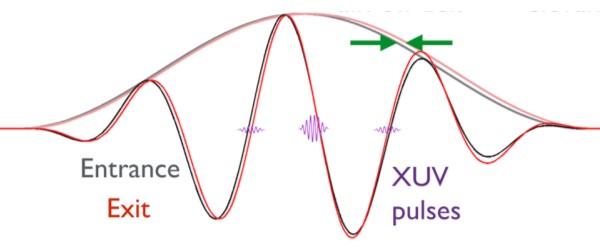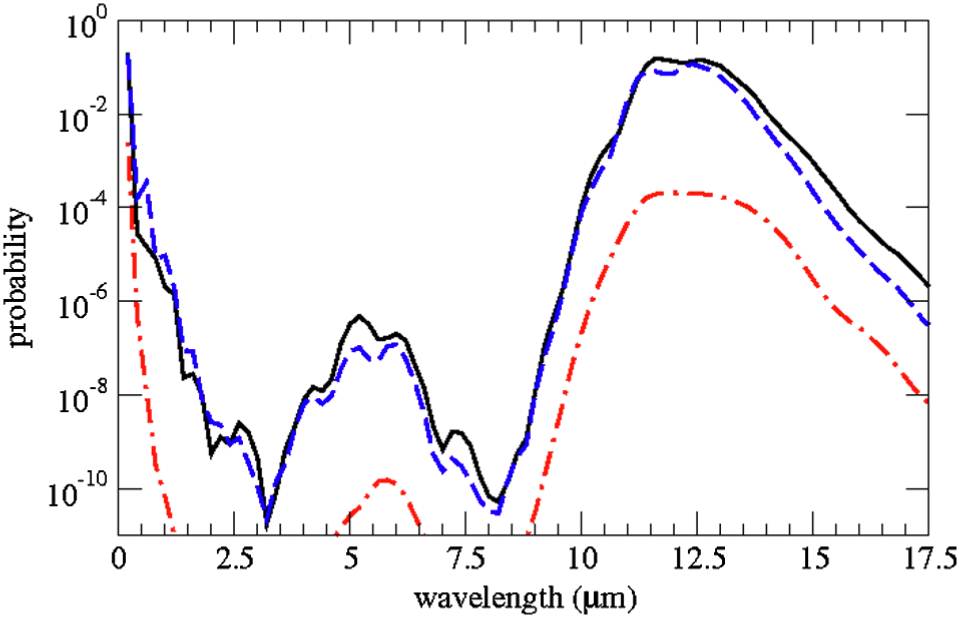Role of Group Velocity Matching
 Surprisingly, experiments in the Kapteyn-Murnane group at JILA, supported by our numerical simulations, revealed that isolated attosecond
soft X-ray bursts can be generated efficiently with long-duration
driver pulses at midinfrared wavelengths. Our theoretical analysis has shown that group velocity matching
between the driving laser and the X-ray fields is
a relevant factor in the isolation process. To study the effect on high harmonic generation, we have introduced a definition of the walk-off length
in the nonperturbative intensity regime. Semiclassical predictions based on this definition are in excellent agreement with
full quantum simulations
- in collaboration with M. Murnane and H. Kapteyn (JILA).
Surprisingly, experiments in the Kapteyn-Murnane group at JILA, supported by our numerical simulations, revealed that isolated attosecond
soft X-ray bursts can be generated efficiently with long-duration
driver pulses at midinfrared wavelengths. Our theoretical analysis has shown that group velocity matching
between the driving laser and the X-ray fields is
a relevant factor in the isolation process. To study the effect on high harmonic generation, we have introduced a definition of the walk-off length
in the nonperturbative intensity regime. Semiclassical predictions based on this definition are in excellent agreement with
full quantum simulations
- in collaboration with M. Murnane and H. Kapteyn (JILA).
C. Hernandez-Garcia et al., Opt. Express 25, 11855 (2017)
C. Hernandez-Garcia et al., New J. Phys. 18, 073031 (2016)
M.-C. Chen et al., Proc. Nat. Acad. Sci. 111, E2361 (2014)
Targeting Multiple Rescatterings
 It has been previously proposed that at longer mid-infrared wavelengths multiple rescatterings of the electron
from the parent ion play an important role. The detection of the number of these rescattering events however still poses a
challenge to current experimental techniques. We have investigated the interrogation of high-order harmonic
generation by a second pulse and identified signatures of multiple rescattering events in both the
temporal and the frequency domain of the generated harmonic radiation.
It has been previously proposed that at longer mid-infrared wavelengths multiple rescatterings of the electron
from the parent ion play an important role. The detection of the number of these rescattering events however still poses a
challenge to current experimental techniques. We have investigated the interrogation of high-order harmonic
generation by a second pulse and identified signatures of multiple rescattering events in both the
temporal and the frequency domain of the generated harmonic radiation.
M. Miller et al., Phys. Rev. A 90, 053409 (2014)
Enhancement of Dissociation
 It is a long-standing assumption that strong laser pulses cannot induce significant vibrational excitation
and dissociation of a molecule, unless the laser pulse is chirped to account for the anharmonicity of molecular
vibrations. Our results of numerical simulations for the hydrogen molecular ion indicate that this conjecture
may have to be revised. We find an enhancement of dissociation (solid line) over ionization (dashed-dotted line) by many orders of magnitude
for interaction of the molecular ion with an unchirped ultrashort laser pulse at certain wavelengths in the infrared.
The dissociation mechanism is related to an efficient excitation of molecular vibrations via two- and multiphoton
transitions.
It is a long-standing assumption that strong laser pulses cannot induce significant vibrational excitation
and dissociation of a molecule, unless the laser pulse is chirped to account for the anharmonicity of molecular
vibrations. Our results of numerical simulations for the hydrogen molecular ion indicate that this conjecture
may have to be revised. We find an enhancement of dissociation (solid line) over ionization (dashed-dotted line) by many orders of magnitude
for interaction of the molecular ion with an unchirped ultrashort laser pulse at certain wavelengths in the infrared.
The dissociation mechanism is related to an efficient excitation of molecular vibrations via two- and multiphoton
transitions.
A. Picon et al., Phys. Rev. Lett. 109, 163002 (2012)
A. Picon et al., Phys. Rev. A 83, 023412 (2011)
JILA research highlight: Sizzling Vibrations.
Past Projects
Suppressed Molecular Ionization
We have explained the phenomenon of suppressed molecular ionization for a large range of
molecules (up to C60) using a S-matrix analysis.
J. Muth-Böhm et al., Phys. Rev. Lett. 85, 2280 (2000)
A. Jaron-Becker et al., Phys. Rev. Lett. 96, 143006 (2006)
J. Dura et al., J. Phys. Chem. 116, 2662 (2012)